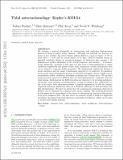| dc.contributor.author | Burkart, Joshua | |
| dc.contributor.author | Quataert, Eliot | |
| dc.contributor.author | Arras, Phil | |
| dc.contributor.author | Weinberg, Nevin N. | |
| dc.date.accessioned | 2013-01-30T20:19:48Z | |
| dc.date.available | 2013-01-30T20:19:48Z | |
| dc.date.issued | 2012-04 | |
| dc.date.submitted | 2011-12 | |
| dc.identifier.issn | 0035-8711 | |
| dc.identifier.issn | 1365-8711 | |
| dc.identifier.uri | http://hdl.handle.net/1721.1/76683 | |
| dc.description.abstract | We develop a general framework for interpreting and analysing high-precision light curves from eccentric stellar binaries. Although our methods are general, we focus on the recently discovered Kepler system KOI-54, a face-on binary of two A stars with e= 0.83 and an orbital period of 42 days. KOI-54 exhibits strong ellipsoidal variability during its periastron passage; its light curve also contains ∼20 pulsations at perfect harmonics of the orbital frequency, and another ∼10 non-harmonic pulsations. Analysis of such data is a new form of asteroseismology in which oscillation amplitudes and phases rather than frequencies contain information that can be mined to constrain stellar properties. We qualitatively explain the physics of mode excitation and the range of harmonics expected to be observed. To quantitatively model observed pulsation spectra, we develop and apply a linear, tidally forced, non-adiabatic stellar oscillation formalism including the Coriolis force. We produce temporal power spectra for KOI-54 that are semi-quantitatively consistent with the observations. Both stars in the KOI-54 system are expected to be rotating pseudo-synchronously, with resonant non-axisymmetric modes providing a key contribution to the total torque; such resonances present a possible explanation for the two largest-amplitude harmonic pulsations observed in KOI-54, although we find problems with this interpretation. We show in detail that the non-harmonic pulsations observed in KOI-54 can be explained by non-linear three-mode coupling. The methods developed in this paper can be generalized in the future to determine the best-fitting stellar parameters given pulsation data. We also derive an analytic model of KOI-54’s ellipsoidal variability, including both tidal distortion and stellar irradiation, which can be used to model other similar systems. | en_US |
| dc.description.sponsorship | National Science Foundation (U.S.) (Grant AST-0908873) | en_US |
| dc.description.sponsorship | United States. National Aeronautics and Space Administration (Grant NNX09AF98G) | en_US |
| dc.language.iso | en_US | |
| dc.publisher | Oxford University Press | en_US |
| dc.relation.isversionof | http://dx.doi.org/10.1111/j.1365-2966.2011.20344.x | en_US |
| dc.rights | Creative Commons Attribution-Noncommercial-Share Alike 3.0 | en_US |
| dc.rights.uri | http://creativecommons.org/licenses/by-nc-sa/3.0/ | en_US |
| dc.source | arXiv | en_US |
| dc.title | Tidal asteroseismology: Kepler's KOI-54 | en_US |
| dc.type | Article | en_US |
| dc.identifier.citation | Burkart, Joshua et al. “Tidal Asteroseismology: Kepler’s KOI-54.” Monthly Notices of the Royal Astronomical Society 421.2 (2012): 983–1006. | en_US |
| dc.contributor.department | Massachusetts Institute of Technology. Department of Physics | en_US |
| dc.contributor.department | MIT Kavli Institute for Astrophysics and Space Research | en_US |
| dc.contributor.mitauthor | Weinberg, Nevin N. | |
| dc.relation.journal | Monthly Notices of the Royal Astronomical Society | en_US |
| dc.eprint.version | Author's final manuscript | en_US |
| dc.type.uri | http://purl.org/eprint/type/JournalArticle | en_US |
| eprint.status | http://purl.org/eprint/status/PeerReviewed | en_US |
| dspace.orderedauthors | Burkart, Joshua; Quataert, Eliot; Arras, Phil; Weinberg, Nevin N. | en |
| dc.identifier.orcid | https://orcid.org/0000-0001-9194-2084 | |
| mit.license | OPEN_ACCESS_POLICY | en_US |
| mit.metadata.status | Complete | |
